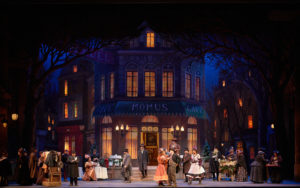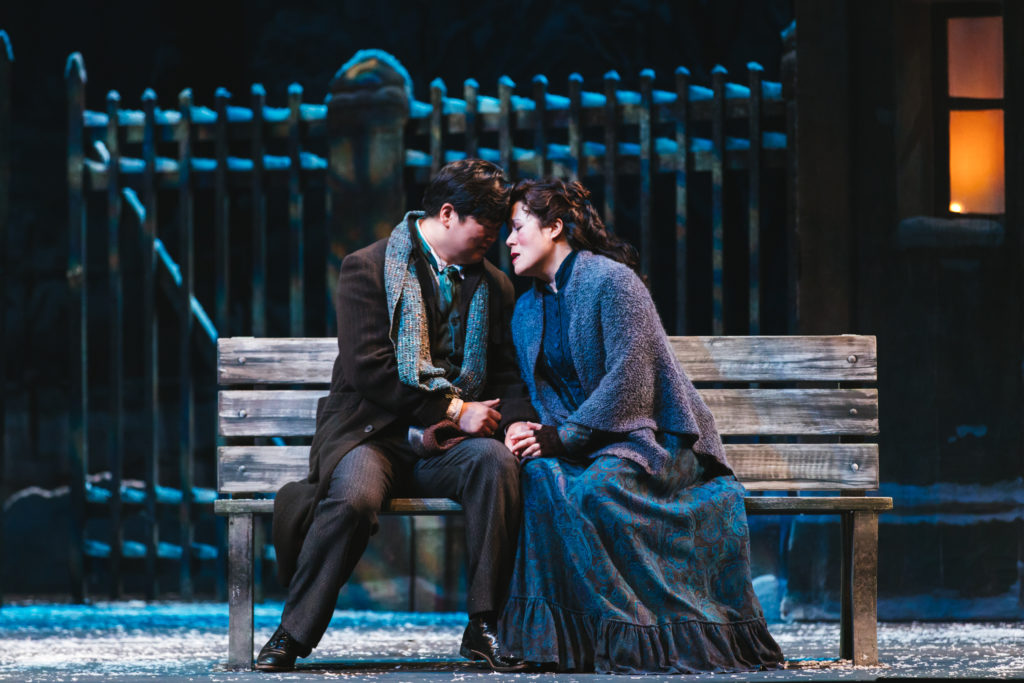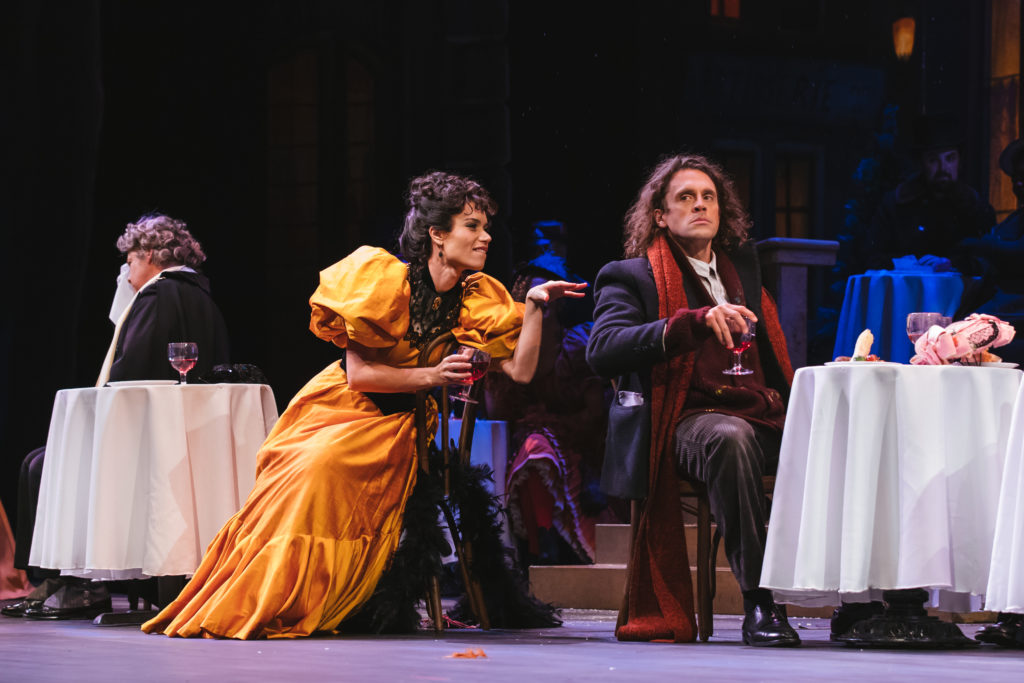
Seattle Opera 2021-22 Review: La Bohème
Seattle Opera Returns to Live Performances with a Traditional, Playful ‘Bohème’
By John Carroll(Photo Credit: Sunny Martini)
Immense goodwill was palpable all through the theater on the opening night of Seattle Opera’s first fully staged live production in 18 months, Puccini’s “La Bohème.” The company adroitly produced its full 2020-21 subscription season through online streaming during the pandemic, so clearly everyone was ecstatic to be back in the theater in person.
Lobby areas across Seattle Opera’s home, the beautifully appointed McCaw Hall, were bustling with masked (and fully vaccinated) audience members greeting each other after a long separation and anticipating the thrill of having live opera carry them collectively away. The theater’s main curtain, a scarlet-red velvet with a handful of red sequins sprinkled across its panels to subtly catch the light as it gently sways, never looked so magical.
Sticking to Tradition
The choice of “La Bohème” for the reopening made sense: it’s an audience favorite with a cast that is young and playful, music that is full of energy and romance, and settings that transport us to another time and place. Darker themes relevant to 2021 were there—artists grappling to overcome poverty, a tragic death from an infectious lung disease—but there were no attempts to particularly underline them in this presentation. The staging was conventional with traditional period costumes and sets, and tended toward the predictable; I don’t recall any moment when the stage business delighted me by illuminating any new facet of the plot or character relationships.
The sets were originally designed by Ercole Sormani in 1965 (these were likely newer recreations or significantly restored as they looked quite fresh). The scenes in Act two outside Cafè Momus in Paris’ Latin Quarter and the snowy Act three toll-gate and tavern were visually beautiful with spatial depth and a sense of atmosphere, evocatively lit by Chad R. Jung.
But the artists’ garret in the first and last acts was disappointing—illogically outsized in scale for starving artists and one dimensional with merely a painted backdrop suggesting a faux staircase and balcony. Additionally more effort should be made with set details to create a stronger sense of life existing offstage past the scenery: for example, when the tavern doorway opened in Act three, there was only blank scenic muslin — no walls, no furniture, no people, no life.
The Bohemian Boys’ Club
All the principal singers sang well and as a crew had a youthful, quirky chemistry. In his house debut, Yosep Kang gave us an impetuous and slightly awkward Rodolfo. This poet was quick to his emotions, but not a deep, complex fellow. His bright tenor had a laser-beam top register — his several cries of “Mimi, Mimi!” were full of penetrating emotion. He was less effective in riding and tapering the swells of lyricism that are at the core of Puccini’s score and key to evoking this conflicted poet’s soul. More guidance from conductor Joseph Colaneri on Kang’s phrasing and use of rubato would have helped elevate Kang’s performance and brought out nuances of the Italianate style that imbue the score.
John Moore, so brilliant as Seattle’s recent Eugene Onegin, was a rakish, big-hearted Marcello. His well-balanced, sultry baritone elevated the music and his authentic acting made the many shifts of Marcello’s demeanor credible, jumping believably from silly antics with his buddies, to fiery jealousy around Musetta, to empathy for Mimi and Rodolfo. With more performances under their belt, Kang’s and Moore’s beautiful duet in Act four where they wistfully contemplate their absent lovers should find more blend and synchronicity.
Rounding out this circle of Bohemian fellows were Ashraf Sewailam as a charming, slightly nerdy Colline and Eugene Villanueva as a suave Schaunard, full of bravado. Both sang well and contributed unique ingredients to the recipe that makes this rag-tag gang so interesting.

Yosep Kang as Rodolfo, Karen Vuong as Mimi (Photo Credit: Sunny Marini)
Gracefulness Personified
Karen Vuong was a demure, but upbeat Mimi. It was a plus that she didn’t telegraph the end of the opera early on, instead letting her illness become more evident and serious over time and giving her character a compelling arc. Vuong has an appealing soft-grained soprano with a lightly spinning vibrato that was an excellent fit for the intimate moments of Mimi’s music.
Her opening aria “Mi chiamano Mimi” was gracefully phrased, “Addio senza rancor” in Act three was elegantly bittersweet, and her final death scene was beautifully vocalized in hushed but clear tones, without unnecessary layers of vocal affectations. In the emotional climaxes, however — for example, the duets with Rodolfo and Marcello in Act three — additional levels of power and tonal richness were missing; high notes were there and attractive, but lacked the grander overtones that make them both musical and emotional peaks (and spine-tingling moments for the audience).
It’s uncommon to cast a mezzo-soprano as Musetta, but with Ginger Costa-Jackson it was choice that worked well and highlighted new facets in the character. She looked fabulous in Martin Pakledinaz’s costumes and carried herself like a savvy Belle Époque “It Girl.” As a mezzo, she naturally offered a welcome vocal contrast to the light lyric voice of Vuong’s Mimi and allayed fears of that stereotypically shrill soubrette version of the character.
Vocal range was not an issue: Costa-Jackson had the High Bs for her famous waltz, and even held out the last one with a smooth diminuendo as if to say: “Take that, sopranos!” The biggest benefit of the casting choice, and to Costa-Jackson’s credit, was how her lower voice conveyed the deep sincerity in Musetta’s feelings at Mimi’s suffering in Act four.

Ginger Costa-Jackson as Musetta, John Moore as Marcello (Photo Credit: Sunny Martini)
Although the orchestra and chorus had been pulled back in numbers (the children’s chorus and the Parpignol section were cut from Act Two), presumably due to budgetary constraints coming out of the pandemic, everything sounded full and confident. Conductor Joseph Colaneri approached the work in a rather straightforward manner, perhaps a little too much so. Part of the score’s best effects are derived from the way Puccini switches gears quickly from motif to motif, weaving, growing, and contrasting with themselves. In Colaneri’s hands, some of those transitions didn’t fully register and the most lush melodies felt a little diminished by not having room to breath and expand, though his crispness was admirable.
What did expand were the hearts and souls of Seattle opera lovers being touched again by the resonance they can only find hearing operatic voices and classical musicians in person. It is great to be back!



